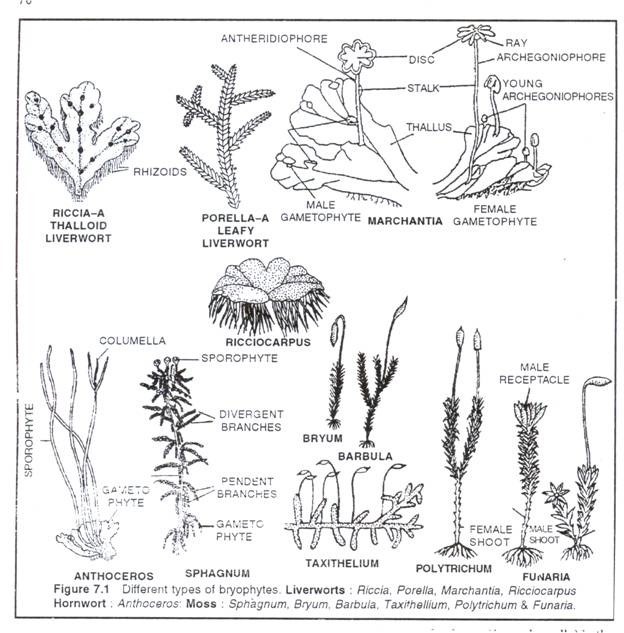ADVERTISEMENTS:
The division Bryophyta (Gr. bryon=moss) includes over 25000 species of non-vascular embryophytes such as mosses, liverworts and hornworts.
Bryophytes are small plants (2cm to 60cm) that grow in moist shady places. They don’t attain great heights because of absence of roots, vascular tissues, mechanical tissues and cuticle. They are terrestrial but require external water to complete their life cycle.
Hence, they are called “Amphibians of plant kingdom”.
ADVERTISEMENTS:
The fossil record indicates that bryophytes evolved on earth about 395 – 430 million years ago (i.e. during Silurian period of Paleozoic era). The study of bryophytes is called bryology. Hedwig is called ‘Father of Bryology’. Shiv Ram Kashyap is the ‘Father of Indian Bryology’.
Salient features of Bryophytes:
1. Bryophytes grow in damp and shady places.
2. They follow heterologous haplodiplobiontic type of life cycle.
3. The dominant plant body is gametophyte on which sporophyte is semiparasitic for its nutrition.
ADVERTISEMENTS:
4. The thalloid gametophyte differentiated in to rhizoids, axis (stem) and leaves.
5. Vascular tissues (xylem and phloem) absent.
6. The gametophyte bears multi-cellular and jacketed sex organs (antheridia and archegonia).
7. Sexual reproduction is oogamous type.
8. Multi-cellular embryo develops inside archegonium.
9. Sporophyte differentiated into foot, seta and capsule.
10. Capsule produces haploid meiospores of similar types (homosporous).
11. Spore germinates into juvenile gametophyte called protonema.
12. Progressive sterilization of sporogenous tissue noticed from lower to higher bryophytes.
ADVERTISEMENTS:
13. Bryophytes are classified under three classes: Hepaticae (Liverworts), Anthocerotae (Hornworts) and Musci (Mosses).
Classification of Bryophytes:
According to the latest recommendations of ICBN (International Code of Botanical Nomenclature), bryophytes have been divided into three classes.
1. Hepaticae ( Hepaticopsida = Liverworts)
2. Anthocerotae (Anthocertopsida= Hornworts)
ADVERTISEMENTS:
3. Musci (Bryopsida= Mosses)
Class 1. Hepaticae or Hepaticopsida:
1. Gametophytic plant body is either thalloid or foliose. If foliose, the lateral appendages (leaves) are without mid-rib. Always dorsiventral.
2. Rhizoids without septa.
ADVERTISEMENTS:
3. Each cell in the thallus contains many chloroplasts; the chloroplasts are without pyrenoi.
4. Sex organs are embedded in the dorsal surface.
5. Sporophyte may be simple (e.g., Riccia) having only a capsule, or differentiated into root, seta and capsule (e.g., Marchantia, Pallia and Porella etc.)
6. Capsule lacks columella.
ADVERTISEMENTS:
7. It has 4 orders:
(i) Calobryales
(ii) Jungermanniales
(iii) Spherocarpales
(iv) Marchantiales.
Class 2. Anthocerotae or Anthocerotopsid:
ADVERTISEMENTS:
1. Gametophytic plant body is simple, thalloid; thallus dorsiventra without air cambers, shows no internal differentiation of tissues.
2. Scales are absent in the thallus.
3. Each cell of the thallus possesses a single large chloroplast with a pyrenoid.
4. Sporophyte is cylindrical only partly dependent upon gametophyte for its nourishment. It is differentiated into bulbous foot and cylindrical capsule. Seta is meristematic.
5. Endothecium forms the sterile central column (i.e., columella) in the capsule (i.e. columella is present). 6. It has only one order-Anthocerotales.
Class 3. Musci or Bryopsida:
ADVERTISEMENTS:
1. Gametophyte is differentiated into prostrate protonema and an erect gametophores
2. Gametophore is foliose, differentiated into an axis (=stem) and lateral appendages like leaves but without midrib.
3. Rhizoids multi-cellular with oblique septa.
4. Elaters are absent in the capsule of sporangium.
5. The sex organs are produced in separate branches immersed in a group of leaves.
6. It has only three orders:
(i) Bryales,
(ii) Andriales and
(iii) Sphagnales.
ADVERTISEMENTS:
Economic importance of Bryophytes:
1. Protection from soil erosion:
Bryophytes, especially mosses, form dense mats over the soil and prevent soil erosion by running water.
2. Soil formation:
Mosses are an important link in plant succession on rocky areas. They take part in binding soil in rock crevices formed by lichens. Growth of Sphagnum ultimately fills ponds and lakes with soil.
3. Water retention:
Sphagnum can retain 18-26 times more water than its weight. Hence, used by gardeners to protect desiccation of the seedling during transportation and used as nursery beds.
4. Peat:
It is a dark spongy fossilized matter of Sphagnum. Peat is dried and cut as cakes for use as fuel. Peat used as good manure. It overcomes soil alkalinity and increases its water retention as well as aeration. On distillation and fermentation yield many chemicals.
5. As food:
Mosses are good source of animal food in rocky and snow-clad areas.
6. Medicinal uses:
Decoction of Polytrichum commune is used to remove kidney and gall bladder stones. Decoction prepared by boiling Sphagnum in water for treatment of eye diseases. Marchantia polymorpha has been used to cure pulmonary tuberculosis.
7. Other uses:
Bryophytes arc used as packing material for fragile goods, glass wares etc. Some bryophytes act as indicator plants. For example, Tortell tortusa grow well on soil rich in lime.

